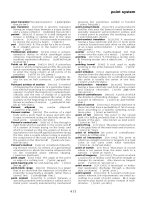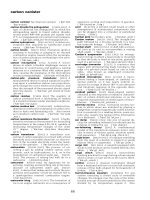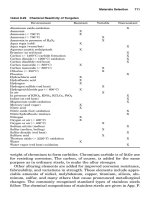Handbook of Lubrication Episode 2 Part 5 ppt
Bạn đang xem bản rút gọn của tài liệu. Xem và tải ngay bản đầy đủ của tài liệu tại đây (1.09 MB, 20 trang )
Hence
K = 9.5 × 1.01 × 10
5
= 9.6 × 10
5
lb/in. stiffness
B = 11.3 × 1.01 × 10
5
/(2π × 30) = 6.05 × 10
3
lb sec/in. damping
These are the dynamic stiffness and damping coefficients for calculating rotor response to
an unbalance excitation.
A load W = ξC/14.6 = 104 lb is required to produce a very small static displacement
(e
o
= ⑀
o
C′ = 0.01 × 0.0075 = 75 × 10
–6
in.). The likelihood of pad resonance can be
calculated from the critical pad mass M
crit
= 1.12 lb sec
2
/in. as shown in the previous
example. The power loss is found to be H = 1.45 × 10
5
lb in./sec (21.4 hp).
Volume II 453
FIGURE 45. Effect of excitation frequency on bearing vertical stiffness (five 60° tilting pads, centrally pivoted,
no preload, no pad inertia, laminar flow).
Copyright © 1983 CRC Press LLC
NOMENCLATURE
B = Slider bearing width (in direction of motion), in.
B, B
xx
, B
xy
, B
yx
, B
yy
= Lubricant film damping coefficient, lb-sec/in.
B′ = r
p
β, Pad arc length (tilting pad journal bearing),
in.
C = r
p
– R = Pad or partial arc radial clearance, in.
C′ = r
b
– R = Tilting pad journal bearing (pivot cir-
cle) radial clearance, in.
C
W, L
C
H,L
;C
Qin,L
; C
Qs,L
; C
ho,L
= Laminar flow performance factors for load, power
loss, inlet flow, side flow, and minimum film
thickness, respectively, dimensionless
C
W, T
; C
H,T
;C
Qin,T
; C
Qs,T
; C
ho,T
= Turbulent flow correction factors for load, power
loss, inlet flow, side flow, and minimum film
thickness, respectively, dimensionless
D = 2R = Journal diameter, in.
454 CRC Handbook of Lubrication
FIGURE 46. Effect of excitation frequency on bearing horizontal stiffness (five 60° tilting pads, centrally pivoted,
no preload, no pad inertia, laminar flow).
Copyright © 1983 CRC Press LLC
D
xx
, D
xy
, D
yx
, D
yy
= Lubricant film acceleration coefficients, lb-sec
2
/in.
F = Friction force or excitation force, lb
F = Thermohydrodynamic (THD) turbulence function,
dimensionless
F
x
, F
y
= Dynamic lubricant film force components, lb
H = Power loss, lb-in./sec
I
p
= Mass moment of inertia of pad around axial axis
(Figure 37), lb-in sec
2
K, K
xx
, K
xy
, K
yx
, K
yy
= Lubricant film stiffness coefficient, lb/in.
K
s
= Rotor stiffness (Figure 35), lb/in.
L = Length (perpendicular to motion), in.
M = I
p
/r
2
p
= Equivalent pad mass, lb-sec
2
/in.
M
crit
= Value of M giving resonance, lb-sec
2
/in.
NSpeed, rev/sec
P = Unit load, W/DL(journal bearing), = W/BL(sli-
der bearing), lb/in.
2
Pe = Peclet number =ρcωC
2
/k, dimensionless
Volume II 455
FIGURE 47. Effect of excitation frequency on bearing vertical damping (five 60° tilting pads, centrally pivoted,
no preload, no pad inertia, laminar flow).
Copyright © 1983 CRC Press LLC
Pr = Prandtl number = v/α, dimensionless
Q, Q
in
= Flow rate into bearing, in.
3
/sec
Q
s
, Q
s1
,Q
s2
, = Side flow flow, in.
3
/sec
R = Journal radius, in.
R
1
,R
2
, = Sector pad inner radius, outer radius, in.
R
mean
= (R
1
+ R
2
)/2, in.
R
p
= Pivot or center-of-pressure radial location, in.
R
e
= Global Reynolds number = RωC/v, dimensionless
R
h
= Local Reynolds number = Rωh/v, dimensionless
Re
p
= Slider bearing Reynolds number = Uh
p
/v,
dimensionless
S = Bearing characteristic number = (R/C)
2
(μN/P),
dimensionless
T = Temperature, °F
T
_
= Mean (turbulent) value of T,°F
T
i
,T
o
,T
s
= Temperature at inlet, outlet, side, °F
T
max
= Maximum bearing temperature, °F
456 CRC Handbook of Lubrication
FIGURE 48. Effect of excitation frequency on bearing horizontal damping (five 60° tilting pads, centrally
pivoted, no preload, no pad inertia, laminar flow).
Copyright © 1983 CRC Press LLC
ΔT = Temperature rise, °F
Ta = Taylor number = (C/R) (RωC/v
2
), dimensionless
U,U
a
= Linear velocity, average value, in./sec
U
1
,U
2
= Tangential velocities, in./sec
V
o
= Normal velocity, in./sec
W = Load, lb
c
f
= Coefficient of wall stress = 8τ
w
/ρU
2
2
,
dimensionless
c = Specific heat, in.
2
/sec
2
°F
e = Eccentricity or displacement of journal with re-
spect to pad or partial arc, in.
e
°
= Eccentricity (displacement) of journal with respect
to bearing (O
b
O
j
), in.
e
°
max
= Maximum possible eccentricity, in.
f = Coefficient of friction = F/W, dimensionless
h,h
a
= Film thickness, average value, in.
h
_
= Dimensionless film thickness = h/C
Volume II 457
FIGURE 49. Effect of preload on four-pad bearing (vertical rotor with slight radial load giving ε
o
= 0.01,
laminar flow, no pad inertia).
Copyright © 1983 CRC Press LLC
h
e
= Film thickness at geometric center of sector pad,
in.
h
p
= Film thickness at pivot location, in.
h
o
= Minimum film thickness (crowned pad), in.
h
min
= Minimum film thickness (sector pad), in.
h
2
= Outlet film thickness (crowned pad), minimum
film thickness (slider bearing, Figure 8), in.
h
n
= Minimum film thickness (journal bearing), in.
k,k
b
= Heat conductivity of oil, bearing, lb/sec °F
k
x
,k
z
= Turbulence functions, dimensionless
m = Mass, lb-sec
2
/in.
m = (C – C′)/C = Preload coefficient, dimensionless
m
r
= Radial slope parameter = R
1
γ/h
c
, dimensionless
m
θ
= Tangential slope parameter = R
1
γ
θ
/h
c
,
dimensionless
n = Number of pads, dimensionless
p = Lubricant film pressure, lb/in.
2
p
cav
, p
atm
= Cavitation, atmospheric pressure, lb/in.
2
458CRC Handbook of Lubrication
FIGURE 50. Effect of preload on five-pad bearing (vertical rotor with slight radial load giving ⑀
o
, = 0.01.
laminar flow, no pad inertia).
Copyright © 1983 CRC Press LLC
p
_
= Mean (turbulent) pressure, lb/in.
2
r
b
= Tilting pad journal bearing (pivot circle) radius,
in.
r
p = Pad or partial arc radius, in.
t = Time, sec
t
_
= Dimensionless time = tω
t′ = Fluctuating component of T,°F
x
_
,y,z
=
Rectangular Cartesian coordinates, in.
x = Pivot or center-of-pressure location, measured
from leading edge, in.
Ω = Excitation speed, rad/sec
Λ = Dissipation number = μω(R/C)
2
/ρcT,
dimensionless
α = Diffusitivity = k/ρc, in.
2
/sec
β
=
Angular extent of pad, sector, or partial-arc, rad
⑀ = e/c = Pad, or partial-arc eccentricity ratio,
dimensionless
Volume II 459
FIGURE 51. Effect of preload on six-pad bearing (vertical rotor with slight radial load giving ⑀
o
= 0.01, laminar
flow, no pad inertia).
Copyright © 1983 CRC Press LLC
⑀
°
max
= ⑀
°
max
/C′ = 1.2361 (For five-pad bearing, Figure
40), dimensionless
⑀
°
′ = e
o
/e
°
max
= ⑀
°
/⑀
°
max
= ⑀
°
/1.2361 = Normalized
bearing eccentricity ratio (for five-pad tilting pad
journal bearing only), dimensionless
φ = Attitude angle, deg
µ = Absolute viscosity, lb-sec/in.
2
= Kinematic viscosity, in.
2
/sec
ρ = Density, lb-sec
2
/in.
4
τ
w
= Wall stress, lb/in.
2
θ
p
= Pivot or center-of-pressure location, measured
from trailing edge, rad
δ = Crown, in.
γ
r
,γ
θ
= Radial, tangential slope of pad, rad
ω = 2πN = Rotation speed, rad/séc
ξ = 2(R/C)
3
μNL, lb/in.
( )
i
= Quantity evaluated at inlet
460CRC Handbook of Lubrication
FIGURE 52. Effect of preload on eight-pad bearing (vertical rotor with slight radial load giving ⑀
o
, = 0.01,
laminar flow, no pad inertia).
Copyright © 1983 CRC Press LLC
REFERENCES
1. Kaufman, H. N., Szeri, A. Z., and Raimondi, A. A., Performance of a centrifugal disk-lubricated
bearing, Trans. ASLE, 21, 315, 1978.
2. Szeri, A. Z., Ed.,Tribology: Friction, Lubrication and Wear, Hemisphere Publishing, Washington, D.C.,
1980.
3. Taylor, G. I., Stability of a viscous liquid contained between two rotating cylinders, Phil. Trans. R. Soc,
Ser, A, 223, 289, 1923.
4. Coles, D., Transition in circular couette flow, J. Fluid Mech., 21, 385, 1965.
5. DiPrima, R. C., A note on the stability of flow in loaded journal bearings, Trans. ASLE, 6, 249, 1963.
6. Li,C.H.,The effect of thermal diffusion on flow stability between two rotating cylinders, Trans. ASME
Ser. F, 99, 318, 1977.
7. Li,C.H.,The influence of variable density and viscosity on flow transition between two concentric rotating
cylinders, Trans. ASME Ser. F, 100, 260, 1978.
8. Gardner, W. W. and Ulschmid, J. G., Turbulence effects in two journal bearing applications, Trans.
ASME Ser. F, 96, 15, 1974.
9. Abramovitz, S., Turbulence in a tilting-pad thrust bearing, Trans. ASME, 78, 7, 1956.
10. Gregory, R. S., Performance of thrust bearings at high operating speeds, Trans. ASME Ser. F, 96, 7,
1974.
11. Ng, C. W. and Pan, C. H. T., A linearized turbulent lubrication theory, Trans. ASME Ser, D, 87, 675,
1965.
12. Suganami, T. and Szeri, A. Z., A thermohydrodynatnic analysis of journal bearings, Trans. ASME Ser.
F, 101, 21, 1979.
13. Suganami, T. and Szeri, A. Z., A parametric study of journal bearing performance: the 80 degree partial
arc bearing, Trans. ASME Ser. F, 486, 1979.
14. Constantinescu, V. N., On the influence of inertia forces in turbulent and laminar self-acting films, Trans.
ASME Ser. F, 92, 473, 1970.
15. Szeri, A. Z., Raimondi, A. A., and Giron, A., Linear force coefficients for squeeze-film damper, Trans.
ASME Ser. F, in press.
16. Alford, J. S.,
Protecting turbomachinery from self-excited rotor whirl, ASME J. Eng. Power Ser. A, 87,
333, 1965.
17. Hagg, A. C., Influence of oil-film journal bearings on the stability of rotating machines, J. Appl. Mech.,
Trans. ASME, 68, A211, 1946.
18. DenHartog, J. P., Mechanical Vibrations, 4th ed., McGraw-Hill, New York, 1956.
19. Raimondi, A. A. and Boyd, J., Applying bearing theory to the analysis and design of pad-type bearings,
Trans. ASME, 77, 287, 1955.
20. Johnston, R. C. R. and Kettleborough, C.F., An experimental investigation into stepped thrust bearings,
Proc. Inst, Mech. Eng., 170, 511, 1956.
21. Wilcock, D. F., The hydrodynamic pocket bearing, Trans. ASME, 77, 311, 1955.
22. Raimondi, A. A., Adiabatic solution for the finite slider bearing, ASLE Trans., 9, 283, 1966.
23. Gross, W. A., Matsch, L. A., Castelli, V., Eshel, A., Vohr, J. H., and Wildmann, M., Fluid Film
Lubrication, John Wiley & Sons, New York, 1980.
24. Baudry, R. A., Kuhn. E. C., and Wise, W. W., Influence of load and thermal distortion on the design
of large thrust bearings, Trans. ASME, 80, 807, 1958.
25. Raimondi, A. A., The influence of longitudinal and transverse profile on the load capacity of pivoted pad
bearings, ASLE Trans., 3, 265, 1960.
26. Malinowski, S. B., Rerate tilting-pad thrust bearings, Mach. Design, 45, 100, 1973.
27. Vohr,J.H.,Prediction of the operating temperature of thrust bearings, Trans. ASME J. Lubr. TechnoL.,
103, 97, 1981.
28. Wilcock, D. F. and Booser, E. R., Bearing Design and Application, McGraw-Hill, New York, 1957.
29. Raimondi, A. A., A theoretical study of the effect of offset loads on the performance of a 120° partial
journal bearing, ASLE Trans., 2, 147, 1959.
30. Raimondi, A. A., Boyd, J., and Kaufman, H. N., Analysis and design of sliding bearings, in Standard
Handbook of Lubrication Engineering, McGraw-Hill, New York, 1968, chap 5.
31. DuBois, G. B. and Ocvirk, F. W., Analytical Derivation and Experimental Evaluation of Short-Bearing
Approximation for Full Journal Bearings, NASA TR1157 and TN2808, National Aeronautics and Space
Administration, Washington, D.C., 1952.
32. Allaire, P. E., Design of journal bearings for high speed rotating machinery, in Fundamentals of the Design
of Fluid Film Bearings, American Society of Mechanical Engineers, New York, 1979, 45.
33. Warner, R. E. and Soler, A. I., Stability of rotor-bearing systems with generalized support flexibility
and damping and aerodynamic cross-coupling, ASME J. Lubr. Technol., 7F, 461, 1975.
Volume II 461
Copyright © 1983 CRC Press LLC
34. Boyd, J. and Raimondi, A. A., Clearance considerations in pivoted pad journal bearings, ASLE Trans.,
5, 418, 1962.
35. Lund, J. W., Spring and damping coefficients for the tilting-pad journal bearing. ASLE Trans., 7, 342,
1964.
462 CRC Handbook of Lubrication
Copyright © 1983 CRC Press LLC
SLIDING BEARING MATERIALS
A. O. DeHart
BEARING MATERIALPROPERTIES
Selection of materials for sliding surface bearings is a multifunctional optimizational
problem: no one material is best for all applications. Commonly considered material prop-
erties include score resistance, conformability, embedability, compressive strength, fatigue,
corrosion, thermal properties, wear resistance, and cost. Unfortunately, a selection based
upon the best value for one of these properties may be improper when all factors are
considered.
In spite of the difficulty, bearing materials are selected for many different applications
every day. If we consider each of the required properties separately, a rational basis should
develop to aid in making the best compromise in finding the right material for the job at
hand.
1-3
Score Resistance
Score resistance, also termed antiweld and antigalling, is the vital ability of the bearing
material to resist welding to the journal under what can be highly distressful conditions.
Many engineering tests have been run to assess the ability of bearing materials to resist
welding to the steel or cast iron commonly employed for journals. Roach et al.
4
showed
that the only elemental metals that have satisfactory score resistance against steel are in the
B subgroup of the periodic table and are either insoluble with iron or form weak intermetallic
compounds. Relative score resistance for various elements is given in Table 1. Although
bearing alloys and mixtures are much more complicated, the performance of elements can
be used as a guideline. For example, adding more of a good material (e.g., lead) to a bronze
will generally improve score resistance, while the addition of a poor metal (e.g., zinc) will
degrade the score resistance.
Strength
Several bearing properties have a relationship to material strength — compressive strength,
fatigue strength, embedability, and conformability. Compressive strength, a basic require-
ment for support of the applied load without cracking or extruding, is closely related to
normally reported physical properties. But the effect of temperature should be reecognized
when choosing a particular babbitt (Figure 1). Ultimate strength for typical babbitt com-
positions is given in Figure 2.
One method of improving the effective compressive strength of weaker materials is by
using a thin layer on a strong substrate such as steel. Providing the bond is adequate, a thin
layer of soft bearing material tends to adopt the stiffness and strength of the substrate.
Fatigue Strength
Fatigue strength is important in bearings subjected to load reversals such as are encountered
with connecting rod and main engine bearings. Not only is the fatigue problem due to the
dynamic nature of the load, but also to the attendant flexing of the support structure. While
fatigue strength varies with temperature and application. Table 2 gives an approximate guide
for various materials. It is clear that fatigue ratings are opposite of conformability ratings.
Fatigue strength is enhanced by bonding a thin layer of bearing material to a steel back to
form the bimetal bearing, particularly when the bearing material thickness is less than 0.1
mm (Figure 3).
Volume II 463
463-476 4/6/06 7:17 PM Page 463
Copyright © 1983 CRC Press LLC
Matching thermal expansion of the bearing to that of the journal is important to maintain
the correct clearance. This clearance is readily controlled with bimetal or trimetal bearings
with steel back construction. But solid wall bearings, where one material is used for the
entire bearing, can cause problems. Poor heat transfer and high expansion rates are major
concerns that have prevented the adoption of plastic bearings in high-speed applications.
Even solid bronze bearings must be used carefully to prevent loss of clearance or retention.
Such bearings must be mechanically located in their housings, because press fits cannot be
relied upon for retention. As noted previously, material strength, and therefore load capacity,
generally decrease with increasing temperature.
Wear
Bearing wear is many faceted. It can take the form of adhesion, abrasion, corrosion, and
fatigue as well as any combination of these. Adhesive wear is associated with score resistance.
If the bearing material welds to the journal surface, the material with the weaker bond is
torn away and wear results. Abrasive wear is a more mechanical process where the harder
material abrades or machines a softer material. Corrosive wear is related, of course, to the
corrosion resistance. Shearing of oil and journal sliding action tend to remove any passivating
films that may form on the bearing surface, so that materials deficient in corrosion resistance
can suffer very rapid wear in corrosive environments. Fatigue wear of bearings can occur
in the large scale already described or on a micro basis at small surface peaks or stress sites.
Score resistance, conformability, compressive strength, fatigue, corrosion, thermal prop-
erties, wear resistance, and cost: in general, these performance requirements cannot be met
with a single material. Amodern-day, high-performance automotive bearing might have
several layers of mixtures and alloys — each engineered to meet a particular set of per-
formance parameters.
METALLIC BEARING MATERIALS
Basically, modern materials fall into five classes: babbitts, copper-based bearings, alu-
minum-based bearings, silver bearings, and porous metal bearings. Representative properties
of the various classes are given in Table 3.
2
Babbitt
Babbitt, named after Issac Babbitt who obtained the first American patent on a special
bearing material in 1839, is used today to describe a number of soft lead- and tin-based
bearing materials bonded to a harder and stronger shell. While bronzes have been widely
used for the backing material, current practice commonly makes use of steel. Where babbitts
have sufficient strength, they are good materials for most applications. They have superior
embedability and conformability and excellent antiscore qualities. Unfortunately, their strength
is limited by temperature.
Effective strength of babbitts can be improved by reducing thickness. The highest strength
babbitts are obtained by electrodeposition of lead and tin or lead, tin, and copper onto a
bearing substrate. On the other hand, in large electrical machinery or in some marine
applications, babbitts as heavy as 10-mm thick are cast onto steel or cast iron supporting
structures and are often mechanically keyed into place. Typically, these bearing systems are
designed for very low unit loads (on the order of 1.4 mPa) with life expectancies of over
20 years. Table 4 gives nominal compositions for tin- and lead-based babbitts.
Tin Babbitt
Tin-base babbitts are the material of choice for corrosive conditions where the increased
cost can be justified. Tin-base babbitts are composed of up to 90% tin with copper and
Volume II 467
463-476 4/6/06 7:17 PM Page 467
Copyright © 1983 CRC Press LLC
antimony additions to increase hardness and strength. Of course, these additions generally
decrease embedability and conformability. SAE Specifications 11 and 12 define two common
tin-base babbitts. These can be cast onto steel, bronze, or brass backs or directly into a
bearing housing. The materials are soft and corrosion resistant with moderate fatigue re-
sistance. They are used for main and connecting rod bearings and for motor bearings in
corrosive situations. This material operates well on either hard or soft journals.
Lead-Based Babbitt
While tin babbitts had always been the bearing materials of choice over lead, the World
War II shortage of tin forced the general use of lead babbitts. Many users were surprised
to find that lead babbitts worked as well as, or, in some cases, better than tin. While their
relative merits were debated, there seemed to be agreement that lead babbitts were at least
equivalent of tin in thin linings, but in thicker linings the tin may be superior. Additions of
tin and antimony have been found generally to correct the inadequate corrosion resistance
with some of the wartime lead babbitts.
Today, most high-performance bearings use some type of plated lead babbitt of nominally
10% tin, with about 3% copper often used to confer additional hardness. SAE Specifications
19 and 190 cover these overplated materials. SAE Specifications 13 through 16 cover four
reepresentative bearing alloys containing enough tin or antimony to confer adequate corrosion
resistance, athough SAE 15 should not be used where there are heavy concentrations of
organic acids. SAE 15 is normally cast onto a steel back while the other alloys are cast onto
steel, bronze, brass, or directly into the bearing housing. SAE 16 is normally cast into and
on a porous-sintered matrix — usually copper-nickel bonded to steel. These babbitts are
soft and moderately fatigue-resistant materials that are widely used in main bearing and
connecting rod applications. While they will operate with hard or soft journal surfaces, they
perform best when the journal surfaces arc smooth — below 0.3 mm R
a
.
Copper-Base Bearings
Copper-base bearing materials are widely used both as solid wall bearings where the
bearing material is also the wall, and as multilayered materials where the copper is either
cast or sintered onto a steel backing. The solid wall bearing may be either cast or sintered,
with the porous bearing being a special case where the sintering is done to maintain an open
structure for lubricant. The solid, cast copper materials are usually classified as tin, lead,
or aluminum bronzes.
Tin Bronzes
Tin bronzes are made up of copper with tin being the major alloy constituent. Zinc is
often added to improve castability with some penalty to score resistance. These materials
are generally strong and hard with reduced score resistance and embedability compared to
most other materials. Although tin itself has good score resitance, it does not improve that
of copper until over 60% has been added (Figure 4). These tin bronzes must rely upon the
lead content to obtain good score resistance at lower tin concentrations. Consequently, they
are best used for high-load situations where low speeds are maintained, with ample supply
of clean lubricant, and with increased journal hardness. SAE Alloys 791 and 795 in Table
5 are typical solid bronze bearing materials that have high hardness and good fatigue resistance.
Leaded Bronzes
Leaded bronzes, which are softer than the tin bronzes, will tolerate more misalignment
due to their improved conformability. The increased lead content also confers additional
embedability and eases their lubricant requirement. In fact, increased lead content improves
most bearing characteristics except those concerned with strength, such as fatigue resistance.
Volume II 469
463-476 4/6/06 7:17 PM Page 469
Copyright © 1983 CRC Press LLC
Copper-Lead Alloys
Containing higher percentages of lead than the leaded bronzes, these have the best score
resistance and embedability of the copper-based bearing materials. Lead content of this group
may go as high as 51% (SAE 485). Copper-lead alloys SAE 48, 49, 480, and 481 have
minimum amounts of tin and arc somewhat subject to oil corrosion. SAE 482, 484, and
485 have 3 to 5% tin. The steel-backed, copper-lead bearing was developed about 1923 by
the Allison Engineering Company and the U.S. Army Air Corp. The first bearings were
constructed for the liberty engine connecting rods.
All copper-lead alloys are either east or sintered onto a steel back. They are moderately
hard with good to fairly good fatigue resistance. They are used for main bearing and
connecting rod bearings in a wide variety of engines. They may be used with or without
plated overlays but recent experience has shown that unplated copper-lead bearings tend to
suffer from corrosion damage in engines operated with unleaded fuel.
In copper-lead-tin bearing alloys the copper is used to support the load, and lead confers
score resistance and embedability to the copper. Since lead is readily attacked by organic
acids, tin is mixed with the lead to prevent corrosion, which it does very well in most
situations as long as tin content is over 3%. After extended periods of time at elevated
temperature, the tin is depleted from the lead by diffusion into the copper where copper-tin
intermetallic compounds are formed that may degrade the score resistance of the basic bearing
material. At the same time, corrosion resistance of the lead is reduced.
Aluminum Bronzes
Aluminum bronzes are popular for manufacturing plant equipment, where great strength
is required without too much concern about score resistance and embedability. These ma-
terials will support high loads at temperatures as high as 260°C (500°F), but they will not
tolerate misalignment or inadequate lubrication. They are widely used as wear-resistant
bearing plates and bushings in machine tools.
Aluminum
Aluminum-based bearings have superior corrosion resistance and good thermal conduc-
tivity. Aluminum has long been used as a solid wall bearing in heavy and medium duty
diesel engines as an aluminum, tin, silicon, and copper composition (SAE 780) or aluminum,
tin, copper, and nickel (SAE 770). Positive bearing location by means such as pinning is
used to keep the bearing in the desired location because the high thermal expansion causes
the bearing to lose retention capability due to yielding of the solid aluminum.
Aluminum materials have fair to excellent antiscore properties. Superior antiscore prop-
erties result when 4% silicon and 1/2% cadmium are added to the basic aluminum while
SAE 782 uses 3% cadmium to obtain the desired score resistance. Both SAE 781 and 782
bearing alloys are typically bonded to a steel back and have a thin babbitt electroplated
overlay for superior antiscore and embedability characteristics.
The venerable 6% tin-aluminum bearing has been used as a solid wall bearing material
as well as steel-backed and overplated for engine applications. The composition is nominally
6% tin with copper and nickel about 1%. SAE 770 and 780 are typical compositions for
the 6% tin-aluminum. SAE 780 is bonded to a steel back with 1
1
/
2
% silicon addition as
well.
In the early 1940s, it was discovered that added silicon considerably improved the score
resistance of aluminum bearings. Cadmium additions from 1 to 3% were also found to
improve bearing properties. Examples of this class of materials are SAE 781 and 782. These
alloys are bonded to steel backs and typically overplated with a thin babbitt to provide
bearings for heavy duty automotive and diesel application; 11% silicon aluminum bearing
alloys are used in Europe for highly loaded diesel bearings.
Volume II 471
463-476 4/6/06 7:17 PM Page 471
Copyright © 1983 CRC Press LLC
Special techniques were found to increase the tin content of tin aluminum. A 20% tin-
aluminum material was developed in Great Britain in 1958. The composition is nominally
20% tin and 1% copper, with special cold-working and heat-treating to provide a reticular
tin-aluminum which is bonded to a steel back without any overplate. It has become the
dominant bearing material in European automotive use.
An alternative to tin-aluminum was developed in this country in 1968. This bimetal
aluminum bearing featured a lead babbitt that was mixed into the aluminum bearing materials
by a novel casting process to develop a lead gradient across the thickness of the aluminum
alloy. The nominal composition of the bearing material of the surface was 10% lead, 1
1
/
2
%
tin, 2% silicon, 1% cadmium, 1% copper,
1
/
2
% magnesium, with the balance aluminum.
This alloy, bonded to a steel back, was developed to fill the gap between the babbitts and
the high performance, more expensive trimetal bearings. Both the high tin and high lead
aluminum materials operate satisfactorily on soft crank journals in a wide variety of con-
necting rod and main bearings in modem automotive engines.
More recently, a sintered lead-aluminum material has been developed for automotive
applications. Nominal composition is 8
1
/
2
% lead, 4% silicon, 1
1
/
2
% tin,
1
/
2
% copper, and
the balance aluminum. These lead-containing aluminums have excellent antiscore properties,
good embedability and fatigue strength, and excellent corrosion resistance. The tin addition
confers adequate corrosion resistance to the lead contained in the aluminum structure, while
the copper improves fatigue strength.
Zinc-aluminum materials are of interest in Germany and Japan. A 5% zinc-aluminum
alloy with 1% addition of nickel, lead, magnesium, and silicon are used as solid wall
automotive main bearings. This bearing is overplated with a lead-copper alloy to improve
compatability. Aluminum alloys of higher zinc content have been publicized in the U.S.
but little comparative performance data are available.
Silver
Silver was widely used in high-performance aircraft engine bearings in World War II.
Their use surged when it was found that a plated, lead-tin or lead-indium overlay (0.1- to
0.025-mm thick) greatly improved the reliability of this bearing. About 0.3-mm silver (99.9%
pure) was electroplated onto a carbon-steel back. These bearings are used today in specialized
applications in high-performance diesel engines and turbochargers. These bearings are readily
made where there is access to a conventional machine shop and to plating facilities. When
properly manufactured, they provide very high load capacity and lend to have a forgiving
mode of failure. After a momentary overload has caused high temperature and resulting shut
down, these bearings can often be restarted to perform satisfactorily. This self-healing
characteristic can be a big recommendation for use in experimental mechanisms when only
a few bearings are needed. Particular attention should be paid to proper lubricant choice
and maintenance to prevent scoring and corrosion damage.
POROUS MATERIALS
Porous metal bushings are widely used all around us for fractional horsepower electric
motors, fans, electric can openers, and the like. They can be premachined or bored in place,
with many bushings being made with simple, self-aligning capability. Since these porous
metal bushings are made by sintering metal powders, they are available in a large number
of material combinations; however, most porous metal bearings are made of bronze or iron-
based materials. By far the most common sintered bushing is 90% copper and 10% tin in
which the pores have been filled with oil. Since they have from 10 to 35% interconnected
porosity, the oil flows freely from the oil reservoir to the bearing surface. Other materials
used are leaded bronzes, iron bronzes, iron with copper, and leaded iron.
472 CRC Handbook of Lubrication
463-476 4/6/06 7:17 PM Page 472
Copyright © 1983 CRC Press LLC
PLASTIC AND OTHER NONMETALLIC BEARING MATERIALS
Plastic-based materials are often used both dry and lubricated in applications where speeds,
loads, and temperatures are low. They are inexpensive and generally compatible with steel
surfaces. The least expensive bushing for minor bearing requirements is molded of nylon
or polyacetal. While these materials can operate without lubricant, their durability is much
increased with some type of lubrication.
Service applications of plastic bearings are limited by thermal conductivity, thermal ex-
pansion problems, and thermal degradation. In fact, an empirical thermal relationship has
been developed that limits the product of the applied load and speed for unlubricated ap-
plications. The generally accepted service limit for these materials is given by a limiting
PV product where P is load in pascals and V is surface speed in meters per second. Typical
values are given in Table 6 for a range of materials.
1,2
Most experimenters develop PV
limits such that the wear will not exceed a given value in a certain number of test hours.
Since the tests vary, there is often disagreement between limiting values. Maximum PV
values can often be increased by using a steel back with a thin sheet of the plastic. Even
higher bearing loads are possible when the plastic is bonded directly to a sintered metal
matrix which is in turn bonded to a steel back to improve thermal conductivity and control
thermal expansion.
When high-temperature plastics such as PTFE or polyimides are used, superior properties
are obtained but the bearings are no longer inexpensive. They do have the advantage of
being able to operate at high temperature without lubricant in specialized applications.
Relatively low-friction coefficients are possible with unlubricated PTFE-based bearings at
high load and at low speed.
Another method of utilizing plastics combines a thermosetting resin such as phenolic or
polyester with a woven fabric such as cotton, linen, or asbestos. They are strong — being
suitable for high-impact applications such as rolling-mill bearings. They are also useful in
marine applications and respond well to water lubrication. Due to thermal instability, they
are not useful above about 107°C.
Rubber bushings also perform well with water lubrication. These bearings are usually
fluted or dimpled and are cooled by axial water flow through the bearing. When combined
with a hard, rust-resistant shaft, they resist dirt damage.
Volume II 473
Table 6
LIMITING SERVICE FACTORS FOR NONMETALLIC AND
POROUS METAL BEARINGS
463-476 4/6/06 7:17 PM Page 473
Copyright © 1983 CRC Press LLC
Carbon graphites are worthy of consideration for specialized application. Their self-
lubricating property enables applications where contamination from a conventional lubricant
would be undesirable — such as in textile or food processing machinery. They are also
useful for temperatures up to 750°F and are resistant to attack from most chemicals and
solvents. Since graphite depends upon absorbed water vapor for its excellent frictional
characteristics, care must be exercised in high-temperature, high-speed, or high-altitude
applications which would tend to remove the valuable moisture. Special proprietary processes
are available to transfer the surface to silicon for extreme resistance to wear. Care must be
exercised to protect these materials from mechanical shock, because they are brittle. This
problem can be reduced by using a metal-filled carbon graphite which also provides improved
material compatibility. Silver, copper, and lead are popular metal additives to carbon graphite.
BEARING CONSTRUCTION
Solid Wall Bearings
Solid wall bearings (Figure 5) can be made from most bearing materials. Two areas of
concern are retention in the receiving hole and maintenance of the required press fit through-
out the operating range. In general, the common solid wall materials (bronze, aluminum
alloys, and plastics) have higher coefficients of thermal expansion than do iron or steel
housings. This causes problems when the bearing and housing are exposed to a wide range
of operating temperatures. If sufficient press is used to retain the bearing at low temperature,
the material may yield when subjected to higher temperature — thereby losing the press at
474 CRC Handbook of Lubrication
FIGURE 5. Sleeve-type half bearings.
463-476 4/6/06 7:17 PM Page 474
Copyright © 1983 CRC Press LLC
low temperature. Consequently, good practice dictates that retaining means other than the
simple press be relied upon for solid wall bearings.
Bi-Metal
Bi-metal bearings involve a steel backing (or occasionally bronze) lined with a bearing
material. The steel backing tends to strengthen the bearing material, increases its fatigue
and compressive strength, and eases retaining the bearing within the receiving hole over a
wide range of service conditions. Substantial press fits may be used to aid in the retention
of a bushing or bearing. Rolled bushings — with and without locking lug construction —
are used in many applications. Where sleeve half-bearings are used, as in automotive engine
applications, bearing crush is used to provide the required press fit for adequate retention.
The backing steel may be stressed to the yield point in applications requiring high crush.
The main complication that arises with the bi-metal bearing is failure of the bearing
material bond to the back. Various techniques are used to ensure a good bond in commercial
bearings. Some manufacturers of aluminum bearings use a thin layer of pure aluminum
between the steel back and the aluminum bearing alloy. Other manufacturers employ elab-
orate chemical and mechanical cleaning operations immediately prior to the bonding oper-
ation. Copper-lead bearings can achieve satisfactory bond by simply casting the material
directly onto the steel back. Heating of sintered bearing material in a controlled-atmosphere
furnace automatically sinters the material and simultaneously effects the bond. Some bi-
metal bearings involving plastics are manufactured by first sintering a porous metal matrix
layer onto the steel back and then causing a plastic material to permeate the matrix and
leave a thin coating over top. A similar technique is used with lead-base babbitt to permeate
a sintered copper-nickel matrix.
Tri-Metal
In these bearings an additional layer is added, most often composed of a thin electroplated
surface of lead and tin. or lead, tin, and copper. This thin layer can substantially increase
the score resistance, embedability, and conformability of the basic bi-metal construction.
Addition of copper reportedly increases strength of the overplate and reduces the wear rate.
Many overplates use a nickel barrier layer of approximately 1-µm thickness under the
overplate which may range from 10- to 25-µm thick. This barrier layer reduces diffusion
of tin from the overplate to avoid leaving the lead in a tin-depleted state where it is subject
to corrosion by organic acids in the oil. This is particularly useful for copper-lead bearings,
but the nickel barrier is also used with some aluminum bearing constructions. After extended
operation at elevated temperature the tin is found to diffuse into the nickel layer to form
nickel-tin intermetallic compounds, some of which are detrimental to score resistance.
In the elegant gridded-silver bearing a pure silver layer is bonded to a steel back and then
gridded and processed so that about 50% of the surface is comprised of about 50% lead-tin
babbitt. Such bearings were used in high-performance aircraft engines in World War II.
These bearings have superior fatigue strength, outstanding antiscore characteristics, and
excellent embedability. They resist corrosion damage in most engine oils. A somewhat less
expensive bearing having almost as good performance can be made by substituting oxygen-
free, high-conductivity copper for the silver.
Volume II 475
463-476 4/6/06 7:17 PM Page 475
Copyright © 1983 CRC Press LLC
REFERENCES
1. Anon., Sliding-Bearing Materials, Mach.Design, 53(14). 148, 1981.
2. Booser, E. R., Bearing materials, in Encyclopedia of Chemical Technology, Vol. 3, 3rd ed., John Wiley
& Sons, New York, 1978, 670.
3. Pratt, G. C., Materials for plain bearings. Int. Metall. Rev., 18, 62, 1973.
4. Roach, A. E., Goodzeit, C. L., and Hunnicutt, R. P., Scoring characteristics of thirty-eight different
elemental metals on high-speed sliding contact with steel, Trans. ASME, 78, 1659, 1956.
5. Crankshaw, E., Mechanical features of sfeel backed bearings, in Sleeve Bearing Materials, American
Society for Metals, Metals Park, Ohio, 1949, 150.
6. Roach, A. E., and Goodzeit, C. L., Why bearings seize, Gen. Motors Eng. J., 2(5), 25, 1955.
476 CRC Handbook of Lubrication
463-476 4/6/06 7:17 PM Page 476
Copyright © 1983 CRC Press LLC









